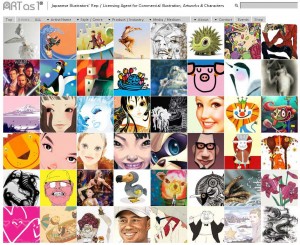WIT Life #232: Gutai at the Guggenheim
WIT Life is a periodic series written by professional Writer/Interpreter/Translator Stacy Smith (Kumamoto-ken CIR, 2000-03). She starts her day by watching Fujisankei’s newscast in Japanese, and here she shares some of the interesting tidbits and trends together with her own observations.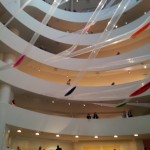
On Saturday I finally had the chance to check out the exhibition Gutai: Splendid Playground (Feb 15-May 8) at the Guggenheim, and it was well worth the wait. Frank Lloyd Wright’s rotunda is filled with Sadamasa Motonaga’s Work (Water), an installation of tubes filled with colored water commissioned by the museum to be recreated for this space.
Gutai (具体) literally means “concreteness” and refers to the way the members of the Kansai-based Gutai Art Association (59 Japanese artists from 1954-1972) sought to directly engage with materials in an experimental way. The group would hold festivals and other events designed to break down the barriers between art, the ordinary public and everyday life.
One interesting aspect of the movement that I wasn’t aware of was its Read More
JQ Magazine: JQ&A with Takashi Ikezawa of Resobox Japanese Art Gallery
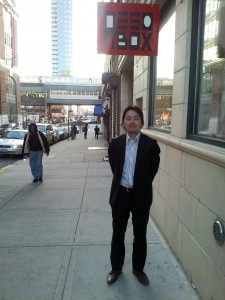
“We don’t want art to be only for wealthy people, but instead want to target as wide an audience as possible for the purpose of disseminating Japanese culture. This is actually the reason why we chose to be located in Queens, as it is said to be the most diverse part of the city.” (Stacy Smith)
By Stacy Smith (Kumamoto-ken CIR, 2000-03) for JQ magazine. Stacy is a professional Japanese writer/interpreter/translator. She starts her day by watching Fujisankei’s newscast in Japanese, and shares some of the interesting tidbits and trends together with her own observations in the periodic series WITLife.
In recent years, Long Island City has experienced a rapid gentrification, being converted from an abandoned, industrial wasteland to a hotspot of waterfront apartments and art institutions. Of course it has big hitters like the Noguchi Museum that are well known to Japanophiles, but there are also Japan-related galleries flying under the radar just waiting to be discovered. One such place is Resobox, a short walk from the Queensboro Plaza subway stop whose location is marked by only a small, overhanging sign and a signboard that sits on the sidewalk reading: “The place where people who are conversant with, dedicated to and influenced by Japanese art can gather, create innovative arts through the collaborative process and disseminate them to the world.” Interest piqued? So was mine, and I was fortunate to have the opportunity to speak with Resobox co-owner Takashi Ikezawa to learn more about this unique endeavor.
Can you share with JQ readers Resobox’s back story and the origin of your name?
Resobox was a name created from the words “resonate” and “box,” and it refers to a space where artists can meet and collaborate to create new and innovative art. It initially referred to a project begun by my partner Fumio Tashiro, a jazz musician who became interested in experimental music and music as art performance. He would collaborate with dancers, painters, and musicians to put together performances. I had a business background as I worked at a talent agency representing Japanese artists in NYC, and I knew Fumio casually. However, we started meeting up monthly to brainstorm, and our discussions always focused on the breadth and depth of Japanese culture and arts. In order for a solid collaboration to take place, you need to have a strong foundation. Since we are both Japanese, we found the culture of our native country to be a foundation substantial enough to build on. Our brainstorming sessions yielded the idea of artists, both Japanese and non-Japanese, coming to our box and resonating off each other to create new Japanese art. This is how Resobox was launched in its gallery form in June of 2011.
Can you give an example of some successful collaborations?
One of the artists who was featured until early January, Mary Burton Wheeler, became involved by taking a Japanese ink painting (sumi-e) class at Resobox. It happened to be taught by Ayakoh Furukawa, the artist we currently have on display, and collaboration began in this class environment. Wheeler learned not just about Japanese painting itself but about Japanese sense and ideas, and she incorporated this into the new pottery she produced as a result. On first glance you wouldn’t say that her work is particularly “Japanese,” but on closer look there is definitely a Japanese sensibility that she encountered via her collaboration with Ayakoh.
JET Alum Artist Beat: Joshua Powell, Book Designer and Illustrator
******* JET Alum Artist Beat is a periodic feature organized by Jessica Sattell (Fukuoka-ken, 2007-2008) intending to share the wide scope of creative work that JET alumni are pursuing as artists, designers, and/or craftspeople. She is interested in interviewing and providing exposure for artists and arts professionals, and welcomes links to online portfolios, stores and businesses. Feel free to email Jessica at hello (dot) jessicasattell (at) gmail (dot) com with suggestions.
Joshua Powell (Saitama-ken, 2005-2007) is a Seattle-based book designer and illustrator. He has designed and produced a number of books for Japan-focused (and JET alum run) independent publisher Chin Music Press, including Shiro: Wit, Wisdom and Recipes from a Sushi Pioneer, which was a 2011 Washington State Book Award Finalist and won First Place in the Quality Paperback category at the 2012 New York Book Show. NPR called another title that he designed, Oh! a mystery of mono no aware, “a triumphant kick in the pants for anyone who doubts the future of paper-and-ink books.”
Josh graciously took the time to discuss his JET tenure and how his experiences in Japan influence his design sensibilities.
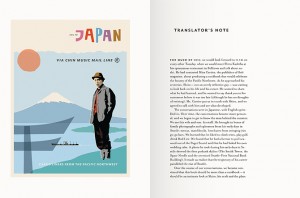
A spread from “Shiro: Wit, Wisdom and Recipes from a Sushi Pioneer” featuring one of Joshua’s original illustrations (image courtesy of Joshua Powell)
Tell us a little about your background. How did you decide to apply to JET and live in Japan?
From the ages of 9-17 I practiced traditional Japanese martial arts, training under a Japanese teacher who had relocated to my home state of Virginia. His two sons as well as other Japanese sensei would visit and teach at the dojo for extended periods of time.
When I was fifteen I was lucky enough to travel to Japan for a karate competition. I never really sought out Japanese culture. I just kind of fell into marital arts and by virtue of that, Japan became a pretty central part of my childhood and teenage years. The trip I took to Japan lasted two weeks, and after it was over I always had this feeling that I wanted to get back and live there – I wondered what it would be like to have things become more familiar, to feel comfortable there. It was a thought that just stuck in the back of my mind, and then when I found out about the JET Program years later, I didn’t think twice about applying.
Were there any experiences while you were on JET that you found particularly meaningful or memorable?
My two years on JET are very important to me – a consistently rewarding and meaningful time. There are many things that contributed to the experience being so great, but it really came down to the people I met and the places I visited while in Japan. I felt extremely lucky with the school I worked at – Omiya High School in Saitama-ken. I had great co-workers, some of whom I considered close friends, and so many enthusiastic and positive students. Outside of work I had some really great friends, other JETs as well as Japanese friends who I mainly met while traveling. There were so many opportunities to get out and explore the country. Unlike many JETs, I only left the country once during my two years. I almost exclusively spent my time off exploring Japan. Coming from the U.S., the ability and ease with which I could explore the country never ceased to amaze me – just hop on a train and you’re off on a new adventure.
One of the things that I came away from Japan with was the knowledge that you don’t need a lot of things to be happy. You can live in a tiny apartment and have few material possessions (no point in buying a lot of stuff when you aren’t staying somewhere permanently), but as long as there are good people in your life and you’re able to get out and experience new things, life can be very fulfilling.
As you mention in your interview with One A Day, you’re trained in printmaking. Has that influenced your work as a book designer?
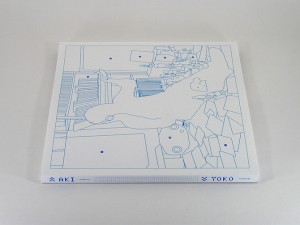
Photograph highlighting the design of “Otaku Spaces” with book jacket removed (image courtesy of Joshua Powell)
Yes. I’m mostly self-taught when it comes to design, so of course I’m building off of the visual language I learned through making art, and particularly printmaking. And of course bookmaking is a form of printmaking – making an edition of ink on paper objects. So naturally, my enthusiasm for the physical book is greatly influenced by my background in printmaking. I’ve always worked with commercial printers – none of which were in Seattle. So in a way that’s very odd, that I’m giving up the actual printing aspect of the whole process to someone else. Nonetheless, since I’m not only doing the design but also handling the production aspect of the process (preparing files, choosing papers, communicating with the printer), I still have a hand in it. If I were to print the books myself or to work closely with a local printer, Read More
Justin’s Japan: Japan Society Presents 15th Contemporary Dance Showcase: Japan + East Asia
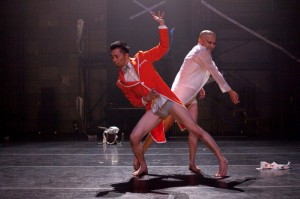
From Tokyo, “Misshitsu: Secret Honey Room,” created and performed collaboratively by Makotocluv founder Makoto Enda (in orange) and former Dairakudakan dancer Kumotaro Mukai (in white), has its North American premiere at Japan Society of New York Jan. 11-12. (Hideto Maezawa)
By JQ magazine editor Justin Tedaldi (CIR Kobe-shi, 2001-02) for Examiner.com. Visit his Japanese culture page here for related stories.
Japan Society swings into the new year with two nights of its upcoming 15th Contemporary Dance Showcase: Japan + East Asia showcase from Jan. 11-12. This year’s program features four North American premieres.
Since the inception of the Performing Arts Program in 1953, Japan Society has introduced more than 600 of Japan’s finest performing arts to an extensive American audience. The program also commissions new works to non-Japanese artists, produces national tours, organizes residency programs for American and Japanese artists and develops and distributes educational programs. Originally America’s leading platform for the introduction of Japanese choreographers and companies, the Dance Showcase has expanded to include artists and works of international acclaim from the broader East Asian region.
From Tokyo comes the U.S. premiere of post-post-post butoh Misshitsu: Secret Honey Room – Duo Version, created and performed collaboratively by Makotocluv founder Makoto Enda and former Dairakudakan dancer Kumotaro Mukai, following a world premiere at Setagaya Public Theatre/Theatre Tram in Tokyo in August 2012. Formed in 2001, Makotocluv appeared at Japan Society in 2008 and was hailed by the New York Times as “wonderfully fluent in the language of the theater.” Misshitsu: Secret Honey Room marks Mukai and Enda’s first collaboration in 15 years.
For the complete story, click here.
Justin’s Japan: A Whole Month of Arts, Events, Music
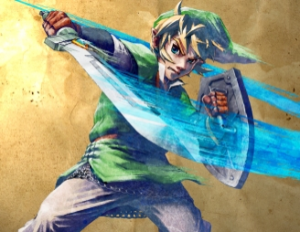
The Legend of Zelda: Symphony of the Goddesses comes to the Theater at Madison Square Garden Nov. 28. (Jason Michael Paul Productions)
By JQ magazine editor Justin Tedaldi (CIR Kobe-shi, 2001-02) for Examiner.com. Visit his Japanese culture page here for related stories.
Hurricane Sandy may have wreaked havoc on the Eastern Seaboard, but New York is holding strong in November with a bounty of Japan-related events from MoMA to Madison Square Garden.
Nov. 6
Nausicaä of the Valley of the Wind Box Set
Nausicaä of the Valley of the Wind is an epic fantasy tale written and illustrated by legendary Studio Ghibli director Hayao Miyazaki, creator of My Neighbor Totoro, Spirited Away, Howl’s Moving Castle and Ponyo. A modern masterpiece (made into its own classic film adaptation in 1984), the entire series is now available in this deluxe box set containing two hardcover volumes with interior color pages and full-color double-sided poster in a special slipcase.
Nov. 9-11
The American Dream Japanese Network (JaNet) was originally created in 2001 following the 9/11 attacks to cheer up and unite the Japanese community, which lost many of its prominent members working in the World Trade Center. An annual Japanese music and performing arts showcase, this year’s three-night event features such diverse acts as Taka Kigawa, Taiko Masala, and Yosakoi Dance Project – 10tecomai, last year’s Talent Night winners!
Monday, Nov. 12
Geisha: The Golden Years 1870-1890 Opening Reception
This Long Island City gallery is proud to present an exhibition of 19th century hand-colored photographs of Geisha and Maiko from the Burns Archive. These photographs are the original images used by Dr. Stanley Burns and his daughter Elizabeth to create their noted book, Geisha: A Photographic History 1872-1912. The images in this exhibition showcase the best of Japanese photographs that were made to show the perceived exotic nature of Japan to the West. Several of the great early photographers’ studios are represented, including Kusabi Kimbel, Ogawa Kazumasa and Baron von Stillfried.
For the complete story, click here.
JET Alum Artist Beat: LeJarie Noguchi, Artist’s Representative at ARTas1
******** JET Alum Artist Beat is a new feature organized by Jessica Sattell (Fukuoka-ken, 2007-2008) intending to share the wide scope of creative work that JET alumni are pursuing as artists, designers, and/or craftspeople, either professionally or for personal enjoyment. She is interested in interviewing and providing exposure for artists and arts professionals, and welcomes links to online portfolios, stores and businesses. Feel free to email Jessica at hello (dot) jessicasattell (at) gmail (dot) com with suggestions.
How do artists get their work into world-renowned galleries? How do companies find ways to visually enhance their brand images? How do publishers find illustrators for manuscripts and cover art? The answers are all rooted in the diverse fields of arts marketing and artist representation! LeJarie (Battieste) Noguchi (Aichi-ken, 1995-1998) is an Artist’s Representative at ARTas1, a Torrance, California-based company that helps bring the visions of dynamic Japanese visual artists to North America through licensing channels and gallery exhibitions. ARTas1 positions itself as a unique firm in that it represents and promotes exclusively Japanese artists. Their goal is to bridge the Japanese and the worldwide art communities into a shared celebration of creative talent, hence the “1” in their title.
LeJarie brings her experiences as a reporter, writer, translator, and Japanese media consultant to her position, where she represents over 70 unique artists working in a wide variety of mediums and styles. She graciously took the time to share a little more about her profession as well as the work of one of her favorite up-and-coming artists.
Tell us a little bit about your background. How did you become interested in Japan and choose to participate in the JET Program?
I majored in Japanese Studies at UCLA, and when I first began my studies, I had never heard of the JET Program. Originally, I thought I would just go to Japan and find a job or continue my studies there. But, when I heard about the opportunity to live and work in Japan through JET, I was determined to go. Thankfully, I was accepted. I didn’t really have a Plan B, but I do remember asking all of my family members for enough money for a one-way ticket to Tokyo if I didn’t get accepted to the JET Program!
How did you become involved with ARTas1?
I saw a job listing there about six years ago and contacted them about the position. At that time I didn’t have any direct sales experience and wasn’t involved much with Japanese art. But then I happened to see another listing with them about two years ago, contacted them, and they hired me! By then I had a bit more sales experience and more experience with art and media.
What does an Artist’s Representative do?
As an Artists’ Representative, Read More
Call for Artists for New Feature: JET Alum Artist Beat
JET Alum Artist Beat is a new feature organized by Jessica Sattell (Fukuoka-ken, 2007-2008) intending to share the wide scope of creative work that JET alumni are pursuing as artists, designers, and/or craftspeople, either professionally or for personal enjoyment. She is interested in interviewing and providing exposure for artists of all mediums, and welcomes links to online portfolios or stores.
The beauty (and the greatest strength) of the JET program is that is attracts such a wide variety of dedicated, talented people from all walks of life. We’re a wonderfully diverse bunch, and JET allows us to further explore and develop our interests, hobbies, and passions within new communities. Whether you’re an alum, a current JET or a prospective JET, we all have stories to tell about how Japan has inspired us, no matter our professional path.
As an aspiring fashion stylist living in Japan during my JET tenure, I saw my own creativity blossom exponentially. My community’s many galleries, museums, cafes and shops spoke to Japan’s inherent acceptance of a DIY mentality and curiosity about art. While I didn’t choose to pursue a path in fashion, I did follow my love of visual art and am crafting a career to help promote the work of artists and creative individuals.
JET Alum Artist Beat aims to profile JETs working as professional artists or who create art for personal enjoyment. There are many JET alums working as artists and in the art world, and many of them wear several different hats! Explore the Art Library here at JETwit to learn more about what some of them are up to, and check out the art category archives for a glimpse of some past projects involving the JET community. There’s also the JET Alum Creative Types LinkedIn group, which is open to new members.
Are you an artist, designer or craftsperson? We’d love to hear your story and share your creative work in a profile piece. Contact Jessica at hello.jessicasattell (at) gmail (dot) com to say hello and introduce yourself!
Justin’s Japan: New York Comic Con Welcomes ‘Sakuran’ Creator Moyoco Anno

Manga author Moyoco Anno with New York Comic Con attendee Joy Charbonneau of Pacifica, CA, Oct. 14, 2012. (Justin Tedaldi)
By JQ magazine editor Justin Tedaldi (CIR Kobe-shi, 2001-02) for Examiner.com. Visit his Japanese culture page here for related stories.
Anime and manga fandom came out in full force at New York Comic Con last weekend, with a record 116,000 fans visiting the Jacob K. Javits Center for the annual event. Sunday (Oct. 14) hosted special guest artist Moyoco Anno of Sugar Sugar Rune and Sakuran fame.
A professional mangaka (manga artist and author) and one of the most respected names in Japanese comics today for her josei (ladies’) comics, Anno was in town to promote the recently released English-language edition of Sakuran, a starkly drawn tale of Japanese courtesans in the Edo period.
“We’d been thinking about publishing Sakuran for a few years now, and were finally able to convince [our] CEO to take the plunge,” said Ed Chavez, marketing director of Vertical Inc., the book’s North American publisher, which had its own booth at Comic Con. Based in New York, Vertical translates Japanese works of fiction and non-fiction that are considered good reads with universal themes from its vibrant book market.
Standouts of Vertical’s manga stable include Osamu Tezuka’s Buddha, Usamaru Furuya’s No Longer Human and Kanata Konami’s Chi’s Sweet Home.
For the complete story, click here.
JETAA Northern California: Pacific Bridge: Fiber Futures: Japan’s Textile Pioneers Opens
This summer and fall, the Museum of Craft and Folk Art (MOCFA) in San Francisco is proud to present a traveling exhibition co-organized by the Japan Society (New York), Tama Art University (Tokyo), and International Textile Network Japan. Fiber Futures: Japan’s Textile Pioneers explores a new art that is emerging from a remarkable fusion of Japanese artisanal and industrial textile making. Coaxed from materials as old as hemp and as newly developed as microfilaments, a varied array of more than 25 works by artists from multiple generations will be on view in this extraordinary two-part exhibition.
By transcending and cutting across the limitations imposed by the inherited oppositions between art, craft, and design, this two-part exhibition brings together over 20 contemporary Japanese artists who are active at the cutting edge of the global fiber-art movement. These men and women transform fabrics into sculptures, pictures, emulations of nature, and even abstract meditations on memory and identity. The materials range from silk, cotton, recycled cocoons, antique paper scraps, jute, and hemp to stainless-steel wire and weaving and dyeing technology. Ultimately the goal is expressing an environmentally sustainable ethos.
The opening reception of Fiber Futures was on July 20, 6-8pm and offered an exciting opportunity to preview the exhibition and meet several artists and curators visiting from Japan. Special guests in attendance included Joe Earle, Vice President and Director of the Japan Society Gallery, and distinguished artists, Machiko Agano, Akio Hamatani, and Hiroko Watanabe (President of International Textile Network Japan). In addition to a delicious sake tasting hosted by the innovative and contemporary Japanese restaurant, Ozumo, who shared some of Japan’s finest premium and limited edition sakes, entertainment included TOMOSAITO, the guitarist/beat producer of FOTOS. The exhibit runs until the 3rd of November this year.
Nicole Crescenzi, Development and Curatorial Associate
Museum of Craft and Folk Art
51 Yerba Buena Lane
San Francisco, CA 94103
For a print version of the article, click here.
JapanLocal: Tokyo Moves Video
Patrick Lee (also known as Pat Leezy) is a current 2nd year JET in Nagasaki-ken who specializes in videography. His videos can be seen on his Youtube Channel. He can be contacted through Facebook and Twitter.
Tokyo is a city of contrasts. Its towering skyscrapers and neon-lit nights suggest a modern metropolis ceaselessly advancing into its future. Yet Japan’s capital visibly prides itself on its rich heritage, preserving various historical landmarks throughout the city. Pat spent a week this past April during cherry blossom week exploring this delicate relationship with his point-and-shoot camera.
SCBWI Tokyo Illustration Day with John Shelley
SCBWI-Tokyo Publicity Assistant Suzanne Kamata (Tokushima 1988-90) shares the following:
Sunday August 19, 2012
SCBWI Tokyo Illustration Day with John Shelley:
Breathing Life Into Your Pictures
Power up your pictures! Give your illustrations vitality and zest! This SCBWI Tokyo Illustration Day featuring illustrator John Shelley will focus on techniques that children’s illustrators use to create resonance in their work and will explore how visual psychology works to convey mood, emotion, and movement. The Action and Emotion Illustration Assignment to be completed in advance of the workshop provides an opportunity for illustrators to develop their craft through open critiques at the event.
Time: Sunday, August 19, 2012, 9:00 am-5:00 pm
Place: Tokyo Women’s Plaza, Audiovisual Room, A & B
5-53-67 Jingumae, Shibuya-ku, Tokyo (by the Children’s Castle and United Nations University). For a map see www.scbwi.jp/map.htm Read More
JET alum wins “Japan Day @Central Park” poster contest
 Congratulations to Aaron Porter (ALT Kyoto-fu, Yawata-shi, 1998-2001), who is the 2012 winner of New York’s “Japan Day @Central Park“ poster contest!
Congratulations to Aaron Porter (ALT Kyoto-fu, Yawata-shi, 1998-2001), who is the 2012 winner of New York’s “Japan Day @Central Park“ poster contest!
From the JapanDayNYC.org website:
“Japan Day – Cherry Blossom Art Contest”
Contest Results
WINNER
To commemorate the 100th anniversary of Japan’s gift of cherry trees to the New York City, Japan Day invited visual artists to submit artwork that featured the beautiful of both cherry trees and Central Park.
Thanks to all of your support, the art contest received total of 45 submissions. All Jurors will agree that, there were a number of impressive entries that made the selection process a challenge. In fact, the Judges also awarded 5 honorable mentions, in addition to choosing a winner.
We are delighted that we can now reveal the winner of the Japan Day Cherry Blossom Art Contest — Aaron Porter and his art work!
【Japan Day 2012 Official Poster Visual using Mr. Porter’s Art Work】
From Aaron’s profile on the Japan Day NYC website:
 Aaron is originally from Chicago and received a Bachelor’s Degree in Scientific Illustration from Northern Illinois University. He began his career as a newspaper artist in South Florida in 1988 in a pre-digital world. Aaron first worked for the Sun-Sentinel in Fort Lauderdale, then the Miami Herald. While in South Florida, Aaron earned a MFA in painting at the University of Miami.
Aaron is originally from Chicago and received a Bachelor’s Degree in Scientific Illustration from Northern Illinois University. He began his career as a newspaper artist in South Florida in 1988 in a pre-digital world. Aaron first worked for the Sun-Sentinel in Fort Lauderdale, then the Miami Herald. While in South Florida, Aaron earned a MFA in painting at the University of Miami.
Shortly after finishing his course work, he was accepted into the Japan Exchange and Teaching Program the summer of 1998. He taught English in four junior high schools in Yawata City (Kyoto Prefecture) and still to this day considers it the most exciting three years of his life. While in Japan, he spent his spare time getting to know Japanese culture and painting. His paintings during this period were most often about Japanese culture. During his time in Japan, he had a painting exhibition at the Kyoto International Center in Kyoto Station as well as a number of other small shows in coffee houses and wherever he could get his work shown.
Aaron returned to the States the summer of 2001 and began his new career in newspapers at The Journal News in White Plains, New York. Presently, Aaron is a part-time digital art instructor at the Bronx Community College as well as a freelance graphic artist and illustrator.
Aaron is married to a Japanese woman from Fukuoka whom he met in New York City after he returned from Japan. They live in Up State New York, visit NYC often and travel to Japan each year to visit her family. Much to his wife’s disappointment he speaks very little Japanese.
WIT Life #197: DC Sakura Matsuri, Part 2
WIT Life is a periodic series written by professional Writer/Interpreter/Translator Stacy Smith (Kumamoto-ken CIR, 2000-03). She starts her day by watching Fujisankei’s newscast in Japanese, and here she shares some of the interesting tidbits and trends together with her own observations.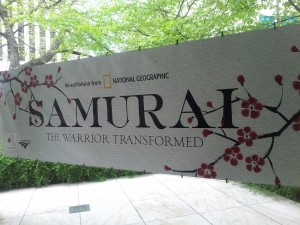
Today is the big parade to celebrate the centennial sakura matsuri, but unfortunately all the blooms are long gone. However, the festival goes through the end of the month, so for those who find themselves in DC there are plenty of Japan-related activities to keep you entertained. I had a chance to sample many of them this week, the first of which I’d recommend being the National Geographic Museum’s samurai exhibit running through early September.
It shares the history of how the now legendary cherry trees made their way to DC, as well as displays unique items such as swords and armor that were gifted from Read More
WIT Life is a periodic series written by professional Writer/Interpreter/Translator Stacy Smith (Kumamoto-ken CIR, 2000-03). She starts her day by watching Fujisankei’s newscast in Japanese, and here she shares some of the interesting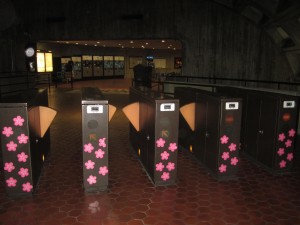 tidbits and trends together with her own observations.
tidbits and trends together with her own observations.
I’m down in DC to begin a new business trip, and was thrilled when I found out my assignment would coincide with the famous Sakura Matsuri. This year is extra special as it marks the 100th anniversary since the 3000+ trees were gifted from Japan to the U.S. Even the Metro gets into the spirit, as you can see with their turnstile decorations. Due to the warm weather it is doubtful that the blossoms will last until the conclusion of the festival at the end of the month, but I’m hoping to do some hanami while I’m here.
On another Japa n-related note, today I went to see an interesting exhibit at the National Portrait Gallery entitled “Asian American Portraits of Encounter.” It features several different Asian American artists, including three Japanese. One is Satomi Shirai based in New York, the second is Shizu Saldamando based in California, and the last is Roger Shimomura based in Read More
n-related note, today I went to see an interesting exhibit at the National Portrait Gallery entitled “Asian American Portraits of Encounter.” It features several different Asian American artists, including three Japanese. One is Satomi Shirai based in New York, the second is Shizu Saldamando based in California, and the last is Roger Shimomura based in Read More
LAST CHANCE – “Fall Flowers of Japan” @ NY Botanical Garden until 10/30/2011
Carolyn Brooks (Ishikawa-ken, Kanazawa, 2006-11) is co-author of the blog MadSilence–a cross-cultural blog written with her father–and a current culture/education related job-seeker in the NY area available for full-time or consulting work.
Feeling a bit homesick for the full moon, momiji and manju that are signs of fall in Japan? Despair not, for 4 days remain of the wonderful “Fall Flowers of Japan” display at the New York Botanical Garden. It will continue until Sunday, October 30th, 10AM to 6PM, and costs (a completely worthwhile) $20 to see. The main focus of the display is kiku, chrysanthemums. They have dozens of varieties to see, including traditional shapes and colors from Japan trained into waterfalls or bridges, and new strains bred in American which look like bird’s nests and exploding stars.

These mums were bigger than a grapefruit, and were so glossy and translucent that they should be made of spun sugar!

